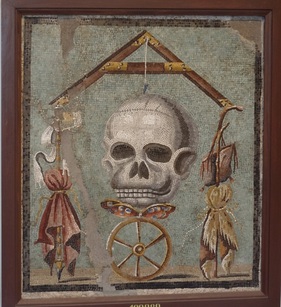

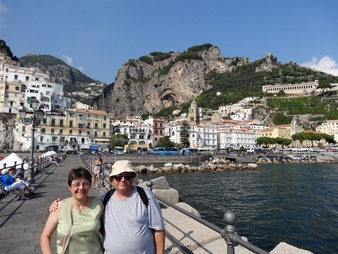
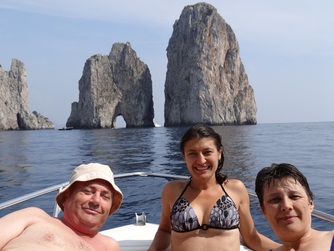
My sister, in her blog Live Love Laugh, wrote about the phrase Carpe Diem from the perspective of a woman who has undergone great tragedy but uses this philosophy as a way to embrace life rather than withdraw from it. As we traveled South of Rome with Neda’s family (they joined us there for a little backpacking family vacation) to Naples and the Amalfi Coast, Carpe Diem became not just a philosophy, but a historical signpost painted over every attraction we visited.  An ominous mural from Pompeii First up was bustling Naples, which with its dirty alleyways connected by interwoven laundry lines was a bit reminiscent of Southeast Asia. The old town’s buildings tower over you as you walk along narrow streets, and the variety of people and noises thrum like the oceans waves. Our main purpose in town was two-fold – eat as much pizza as possible (Naples is the home of pizza!) and visit the Museo Archeologico Nazionale di Napoli, where the treasures of nearby Pompeii and Herculaneum now reside. Both towns were covered under volcanic debris with the explosion of nearby Mount Vesuvius in 79 AD and after being discovered and excavated, stand as some of the best preserved examples of Roman architecture and art available to us today. In the museum, wonderfully vivid murals, sculptures, and paintings have been preserved from the two cities – depicting the mythological, sexual, and everyday art of which the people of Rome adorned their homes and temples. My sister’s philosophy rang through the halls as I imagined the people huddling for shelter while volcanic mud claimed their lives and embedded them into our imagination 2000 years later.  A recent pic of our lady On the pizza front, we ate at “Brandi Pizzeria” the first pizzeria in the world and home of the traditional pizza margherita, which was created in 1889 when the chef of Brandi created a pizza with tomato, mozzarella cheese, and basil for the visit of Queen Margherita di Savoia. Meant to represent the Italian flag with its ingredients, this was the first time cheese was added to this flat bread, transforming it into one of the most popular foods in modern history. Today, the pizza chefs at Brandi are still slinging delicious pies as we found out in person. Though it must be said that for us there is only one Brandy truly in our lives – we miss you little one! It was a thoroughly successful day in Naples, and was followed the next day by a trip to the ancient ruined cities in person where we walked the streets that bustled with life prior to the eruption. Herculaneum is smaller and better preserved than Pompeii, making it a favorite with its ruined bathhouses, villas, and food shops while Pompeii offers a glimpse of the vast destruction caused by Vesuvius.  Nadia and Petko at Amalfi From Pompeii we traveled around the bay of Naples to station ourselves in Sorrento for the exploration of the Amalfi Coast. The coast is named after the maritime empire of the city of Amalfi that once dominated the area. But “Carpe Diem” would linger in our minds when we learned that most of the city, with its population of 70,000 souls, slid into the sea along the steep cliffs of the coastline during an earthquake and ensuring tsunami in 1343. The theme resonated even deeper in our brains as we tottered and swerved along the coastal road on the public bus to get to Positano and Amalfi, only a meter or so away from the steep cliffs that claimed the city hundreds of years before. Today both Positato and Amalfi sit along the coast in defiance of their location, beautiful cities carved upward from the edge of the cliffs into the hills above. We enjoyed perusing the art galleries and letting our eyes water at the prices of food and drink before returning back the way we came on an overcrowded bus trip that afforded beautiful views of the setting sun.  Finally, we headed to the Island of Capri, fabled location of Emperor Tiberius’ summer home and popular jet-setting destination. We rented a “motorized dinghy” to get the real tour of the island and spent four hours gaping at the island’s sheer rock walls lifting out of the sea, snorkeling at the green and white grottos, and sailing through the arched gap in the Faraglione di Mezzo with our little dinghy. As we rounded the island, we could see the fabled Tiberius’ Leap, where legend has it the emperor would have undesired guests and disobedient servants thrown. Near the end of the ride, as we crossed the wake of a giant ferry, we felt like one of Tiberus’ guests and said a final Carpe Diem as the bow of boat lurched upward to the sky before finally settling back safely into the frothy sea. Seeing the precariousness of life over history in the Bay of Naples region beckons one to find appreciation in whatever moments we have on this globe. On this part of the trip we found that appreciation in the time spent with family and the beauty of Italy’s coast. I still hope each day that my sister and her husband continue to find it as they struggle to seize the day in the midst of a tragedy just as world ending as any volcanic eruption or earthquake could ever be.
0 Comments
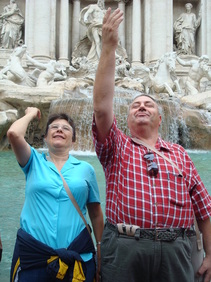 "We'll return to Rome!" On the morning of September 4th, the Bulgarian clan descended upon Rome like Hannibal, with his famed elephants, never could. Petko and Nadia (Neda’s parents) flew in from Bulgaria and Dimitre (Neda’s brother) took the long haul from Boston while we arrived early on the night train from Venice. Our spacious apartment gave us ample space to unwind before beginning a whirlwind tour of Rome’s sites – the Vatican Museum, Sistine Chapel and Saint Peter’s Basilica on one day, the Pantheon, Spanish Steps, Trevi Fountain, and Piazza Navona another, and the ancient Rome of Palatine Hill, the Forum, and the Coliseum on the last day. It was the first time this part of our family had ever visited Western Europe and the first time in our trip of the world that we have been joined by family. Italy is a great place for such a meeting, as the wonderful cuisine and multi-course meals provide time to catch up and enjoy the company. I’ll skip description of the common tourist attractions above because there is already so much information about them available online or in books (though I will pepper in some pictures of them below). But one slightly lesser known attraction turned out to be my favorite and was tremendously fitting to visit with a family of Bulgarians! 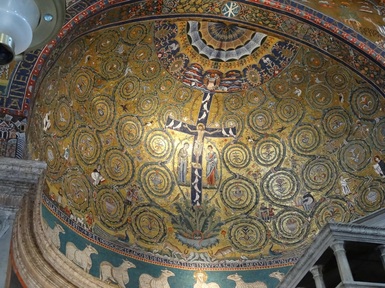 The Tree of Life San Clemente Church sits about a half of a kilometer from the Coliseum and at first glance, it appears to be another beautiful 12-13th century building in Rome. Its central nave features a golden fresco of Christ connected to a “Tree of Life”, a winding network of vines that demonstrates the interconnectedness of life. This is the first clue that this church is a bit different from others, as such an explicitly eastern theme rarely occurs in the churches we've seen so far. But the real beauty and intrigue of San Clemente lies beneath it. It is here that a 4th century church has been preserved in the catacombs of the newer church. This original San Clemente church is haunting to walk through as its LCD lit rooms provide just enough light to imagine worshipers here over 1500 years ago. 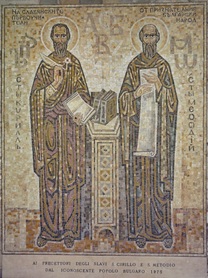 Cyril and Methodius For us the main attraction lay in one of the side naves of this ancient building. It is here that Saint Cyril is buried. Cyril, along with his brother Methodius, created the foundation of the Bulgarian written language, called Glagolitic. Cyril had been in Rome to argue that the church liturgy should be spoken in Glagolitic so that the natives of the Slavic regions could understand it. This was opposed by the German clergy, who had used Latin in the region to maintain their position. Cyril convinced the pope that Glagolitic should be allowed, but died shortly after. The Pope wouldn’t let him be returned to his home so his brother asked that he be buried at San Clemente church (whose body the brothers had returned to the Vatican just a year earlier from the Black Sea). Cyril’s tomb was surrounded by tablets inscribed with messages from the nations and peoples he had influenced. There were tablets from the Serbians, Ukrainians, Russians, Slovenians, & Croatians. The Bulgarians had sent a beautiful mosaic of the two Saints to sit opposite the tomb, in honor of the language that Cyril and his brother had given written form. Bulgarians hold a special regard for the Cyrillic alphabet, as it was fully refined from the Glagolitic alphabet Cyril and Methodus had created by their students under the sponsorship of Kings Boris and Simeon during the 1st Bulgarian Empire. It was touching to see all the nations that had honored this man who had helped create a common written bond between them. Much like the Christ depicted in the church above, Cyril’s tomb was a testament to interconnection. 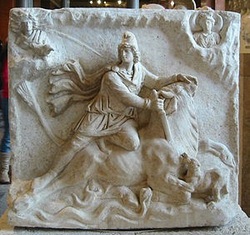 Mithras slaying the bull For most visitors to San Clemente, the interesting part of the visit is not just the 2nd church that lies beneath, but the even older archeological area beneath the 2nd church! It is here that archaeologists have discovered the best preserved “mithraea” (underground temple of the religion of Mithraism) in the world. Very popular among Roman soldiers between the 1st and 4th centuries, the Mysteries of Mithras revolved around the story of the God Mithras slaying a wild bull for the God of the Sun. As the bull dies, its blood gives life to the ground around it. Initiates would eat bread and water to represent the body and blood of the bull and the life it gives out of its death. Citied as an early competitor with Christianity, Mithraism shared many of the same rituals before being systematically destroyed by the early Christian Church. That is why many mithraea have been found with Church’s built on top – a symbolic representation of Christian domination over its competitor. With ancient religions lying beneath the foundations of the Bulgarian ancestral language, Rome proved to be a penetrating historical experience for all of us. From there, we would head down to an equally interesting region of Italy – the Bay of Naples, where ruined cities and the ghosts of the past waited.
To see all the pics of Rome, some of which were taken on Jeff's new Sony Cyber-shot DSC-HX30V camera, which includes GPS tracking of our shots, click here! 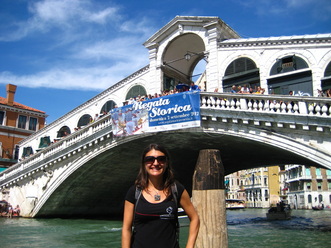 The Rialto over the Grand Canal With Slovenia and Croatia so heavily influenced by the power of the Venetian Maritime Empire of the middle ages, we felt it a natural next stop as we headed into Italy. Venice was bustling during our weekend there with two big events occurring – the Regatta Storica and the Venice Film Festival. Our first night in town we marveled at the city’s interwoven web of bridges connecting the 170 islands that make up Venice proper. Crossing from island to island so seamlessly over intricately carved arched bridges is a reminder of the architectural genius that was required to turn this swampy marshland into one of the most powerful and beautiful cities in history. As we wandered along, we serendipitously came across Piazza San Campo, where we saw a line of people waiting for tickets to a showing of the film festival. Our timing was perfect and we snagged two tickets to “At Any Price” starring Zach Efron, Dennis Quaid, and Heather Grahm (we missed the premier the stars attended by only a day!). After enjoying a quick bite of our first “pasta fresca” (homemade fresh pasta, which in comparison to typical package pasta in America is wonderfully firm and flavorful), we headed to the movie, which was showing on a giant screen right in the middle of the piazza. The film is a compelling drama revolving around the plight of the small American farmer as he sacrifices his values to an “expand or die” mentality and becomes increasily boxed in by the ominous reach of Monsanto’s GMO seeds. These genetically modified seeds are patented by Monsanto and require farmers to buy entirely new seeds each year rather than clean and re-plant the seeds as they have been doing for centuries. The movie also features heavy doses of American iconography, with Nascar, the National Anthem, and loads of shots of Iowa cornfields. The result was that I ended up feeling closer to America than I had since leaving over a year ago. What a strange feeling to have while sitting in the middle of a 500 year old piazza in Venice! 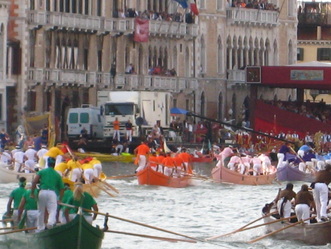 The Regatta Storica The rest of our time in the city involved lots of walking as we explored the city’s circuitous routes. We caught a bit of the Regatta Storica on the main canal as thousands of Venetians donned traditional garb and raced their boats and gondolas along the canal in a tradition harkening back to Venice’s days of maritime glory. We gaped at the amazing Piazza San Marco where the enormous bell tower occludes the sky and the gorgeous church gleams golden in the sun. We also struggled a bit to find good restaurants in this town whose daily count of tourists outnumbers residents! With copious copertos (a charge for sitting down which seems to get you nothing but some stale bread) we bounced like ping pong balls through the streets looking for a decent place to eat. By the end, we were ready to hop on our nighttrain and get down to Rome to meet the family, but we were happy to have gotten to experience some charm and Romance in Venice.
Dreams have always intrigued me and leave me wondering if they have a deeper meaning. Does the brain weave nets of subconscious thoughts that can only be unraveled in the middle of the night? I remember my dreams often, more often than most people I know. And in nearly all the dreams I remember I am running. Running from something, from anything. Sometimes, I am running from aliens or from Roman soldiers, through woods or between canyon walls. Usually, the colors are so vivid and the dreams so engrossing, that I awake panting and looking around - only to find my bedroom and Jeff sleeping peacefully at my side. 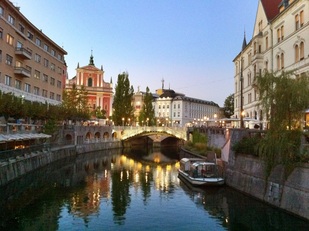 Beautiful three bridges in Ljubljana But something changed in Slovenia! For the first time in my life, a different kind of dream was revealed to me. In this plot, I was a detective and was determined to catch a serial killer. Finally, the tables were turned and instead of running away from a killer, I was running after one to stop another murder from happening. This feeling of empowerment in the dream caused a rush of relief to wash over me as I awoke that morning. I felt like the dream was a prophesying a time when I would have the opportunity to turn the tables on my fear. Or was the dream simply an affirmation of the many fears I have already shed during this travel time? 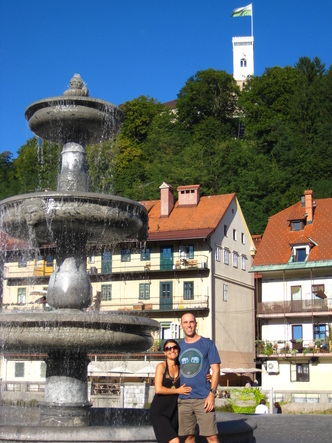 The central plaza with the castle in the background Slovenia, much of which is nestled in the Julian Alps, brought some of the most beautiful mountain scenery we have encountered thus far. We started in the capital city of Ljubljana, a lovely town towered over by its beautifully restored castle. Ljubljana is one of the smallest capitals in Europe and doesn’t have any major ‘attractions,’ which makes it great for strolling the streets while scoping out gelaterias and sweet shops. The charm of the city is largely attributed to Jože Plečnik, who largely rebuilt the city’s waterfront and key civic buildings after an earthquake in 1895 left the city an open palette. His playful and seducing architectural buildings and bridges give the city a feel of enchantment that is augmented by the stunning views we enjoyed from the castle. For pictures from Ljubljiana, click here - http://flic.kr/s/aHsjBT2hNS. After some time in the city, we were ready for nature and moved on to Lake Bled, our base for exploring the Julian Alps. Lake Bled may be one of the cutest little towns in Europe! The homes looked so idyllic they could have come straight from a movie and they all surround this gorgeous glacial lake that was formed when the Bohinj Glacier melted after the last Ice Age. Even more romantically beautiful, the receding glacial waters left a tiny little island in the middle of the lake. It now holds the Church of the Assumption, a 17th century baroque church, though excavations have found remains of a Slavic cemetery and a pre-Romanesque chapel. The island was considered a place of great importance to the local Slavic tribes who lived here before Christianity. They so fiercely defended this little island that the Romans could never overtake the area, despite it being right next door to modern day Italy! With the Julian Alps as the backdrop to this picturesque lake and its little island, the view from the Mala Osojnica viewpoint (which we climbed at a breakneck pace to beat the sunset) was breathtaking! 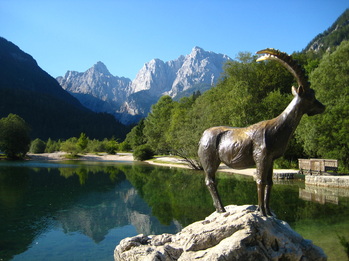 The Goldhorn at the entrance to Triglav Our second day was a small tour full of adventures all throughout the park, which takes up about a third of the country. The jagged ridges of the mountains are dramatic against the blue sky, and always look like they are covered in snow due to the crumbling rock atop. The symbol of the locals is the Goldhorn, a type of buck, who is highly respected in this area. It lives at the highest peaks of these mountains and the end of its horns really shine as if they were gold. Ancient myth says that at one point Triglav park was a paradise of greenery and soft hills where humans and magical creatures lived in harmony. Ruling over it all was an immortal white Goldhorn. During this time, three mountain ferries known for their fortune telling abilities had a vision after a local boy was born in the mountains. The fairies saw that the boy would one day kill the Goldhorn for his gold and ruin the paradise they all enjoyed. Two of the fairies refused to speak of the vision, but the third fairy voiced this prophecy and was cursed by her two sisters for doing so. She was turned to stone by the curse and it is said that you can still see her petrified face edged in the mountain stone. 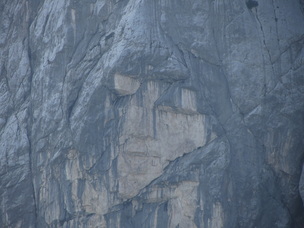 The Petrified Fairy, Julian Alps In the end, the prophesized boy grew up and fell in love with a beautiful Slovenian girl who had also caught the eye of wealthy Venetian merchant. The merchant showered her with expensive gifts that the pour hunter boy could never match. So he decided that only by killing the Goldhorn and collecting his golden horns could he compete with the merchant and win over her love. After an epic three day chase, they met on a ridge where both man and beast stood facing each other. The boy shot at the Goldhorn and his aim was true. The arrow pierced the beasts neck and blood started to gush onto the ground. But to the boys surprise, where the blood hit the ground, beautiful white alpine roses immediately sprung up and blossomed. The Goldhorn ate the flowers and his wound immediately sealed up and healed. In a rage now, the Goldhorn charged the boy, who tried another arrow but missed as he was blinded by the reflection of the oncoming horns. He took the charge straight on and tumbled down the hills to his death. The prophecy was broken. But so was the Goldhorn’s faith in humanity. The immortal beast was made with rage and disappointment as he ran across the planes, thrashing them into the jutting mountain peaks we see today. Nobody has seen the Goldhorn ever since, but locals say the tale cautions us to respect both the power of nature and also its fragility to human greed. 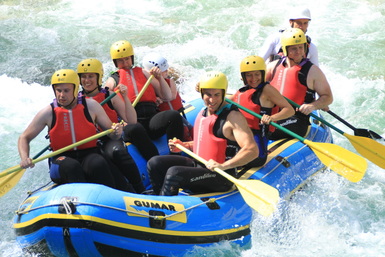 Rafting the soca The next part of our tour took us on a rafting adventure down the Soca River, or Emerald River, as the locals call it. The river is bright turquoise green and its crystal clear water is full of the rare species of trout, called marble, who can grow to be over a meter long! It is mesmerizing to look into the water and chilling when you jump in! Though the river was relatively low due to the drought this summer, the guides still made the trip lots of fun by setting up water slides with the rafts and offering us some optional challenges. Here is where my own dream (or prophecy?) comes into play. One of the stops of the trip was a huge, 8 meter (due to the low level of the river) high rock, edged into a deep pool of emerald water. The guide warned us that the jump looks much higher once you’re up there and that there is no easy turning once you go up. I hesitated for a moment as no other girls even attempted to climb the rock. But then I thought of my dream and scaled the stone. First up, Jeff jumped into the water with little hesitation, though he admitted that it was quite scary for him too! As the 2nd to go, when I reached the ledge of the rock, I found myself frozen in fear, especially since one of my biggest fears is of heights! We have climbed many waterfalls, mountain tops, and tall buildings through these travels, and with each journey I can feel a little bit of my fear melting away. But I have to say, jumping 8 meters into a foreboding flowing river is a whole another different story! After much coercing by the guide and encouragement from the crowd, I finally gathered the courage and jumped. Unfortunately, there was a photographer documenting our whole river trip (pics here) and he caught a really good picture of me on the way down. I didn’t know that my face could contort to this position! In this land of prophecies I was happy that my own came true. As in my dreams, I had overcome my fears and become the hero of my story instead of the victim. We finished our time in Bled by renting a row boat and visiting the little island. Rain forced us to act quickly and Jeff to row like a madman to get back to the mainland. We took this opportunity to relax and enjoy an afternoon in our little apartment as we prepare to cross into Italy with a stop in Venice en route to Rome to meet my family! For pics from Triglav and Bled, click here - http://flic.kr/s/aHsjBSZJ1s.
Croatia is a country still trying to find itself after 46 years of communist rule followed by a brutal war where Croatia fought against Serbia and the former Yugoslavia army for its very existence. It was only in 1995 that it established its independence and found a semblance of stability. Now, 17 years later, Croatia is on the cusp of EU membership and its economy is held afloat by the massive amount of tourists that visits its nearly 6,000 kilometers of beautiful coastline. 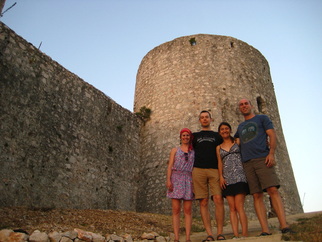 Amy, Tom, Neda, and Jeff at the Crikvenica fortress Tom introduced us to some classic Croatian dishes like black cuttlefish risotto and the home made “surlice” noodle served with white wine, cream, and fresh seafood. Croatia was under Venetian rule for nearly 700 years and so Italian influences intertwine with the typical Slavic kitchen in delightful ways. The fresh seafood and pasta were highlights of our time there. While in Crikvenica, we also got to meet Tom’s parents and enjoy some delicious meals with them. Tom & Amy took us on a day trip to the island of Krk where we swam in deliriously clear turquoise water and sampled white wines made from the delicious local Zhlatina grape. Perhaps the most fun came as we were riding along the road and spotting bountiful fig trees, heavy with unpicked fruit. Tom would pull off to the side of the road and we would all run out to collect as much booty as possible. A few extra plastic bags that Neda brought were soon stuffed with ripe figs. We ate so many that our tongues went slightly numb, but it didn’t stop us from feasting on surlice while enjoying beautiful views of the Croatian mainlaind across the sea. Thanks for your hospitality, Golubs! See all of our pics of our time with Tom and Amy here: http://flic.kr/s/aHsjBC1StJ. 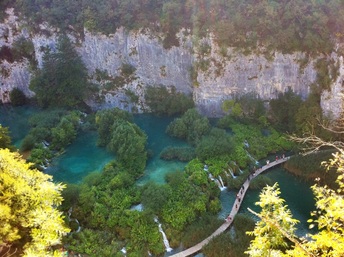 Plitvice lakes from above We parted with Tom & Amy for the only part of our trip that took us inland – Plitvice National Park. Plitvice is formed from several lakes connected by underground rivers and limestone karsts. The movement of the calcium rich travertine around the lakes has formed numerous waterfalls and cataracts, which when combined with the gorgeous hue of the lakes water, makes for a magical experience. The entire lake complex is lined with wooden walkways that traverse the swampy parts of the lake and allow you to get some amazing views of the falls. With only a few hours to see the park before trying to catch an onward bus, however, Neda and I found ourselves dodging past tourist after tourist on the walkways as we took in as much of the park as we could. See all the pics of Plitvice here: http://flic.kr/s/aHsjBD1Fhs. Bus service from Plitvice is pretty limited and after missing the bus to Zadar, we had only one other possible bus we could catch to the rarely visited city of Knin, known mostly for its cliffside fortress and for being the stronghold of the Serbian push to takeover Croatia. We tried hitchhiking to get to a better destination down south, but were met only by zooming cars for over a half hour. Finally, the bus to Knin pulled up, and lacking any other options, we got on! It was one of our more adventurous days in Croatia because as we talked to some locals on the bus to Knin we found out that accommodation was pretty scarce in town. Eventually, a Croatian woman from the bus talked to a local at the station who was kind enough to drive us to the only hotel in town – a shabby little place that still charged us $50 for the night because it was “high season”. That was just the beginning of our realization that Croatia was going to be one of the most expensive places we’ve visited over the whole of our travels. The exhausting day at Plitvice was going to be followed by another national park full of waterfalls, but at the last moment at the Knin bus stop we changed our minds and ran over to a train headed for Split. Without a car, the logistics of seeing Krka National Park was nightmarish and we’d just had enough. It turned out to be the right decision. 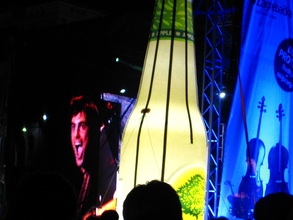 Crazy celoist rocking out We arrived in Split and a local woman waiting at the station convinced us to check out an apartment she had just outside the center. The place was wonderful at the right price so we spent 3 nights in Split, enjoying all the city had to offer. On the first night, two famous Croatia celloist played pop-rock songs on the waterfront – a spectacle that couldn’t help but make Neda and me laugh at some points. Check out their rendition of smells like teen spirit: http://youtu.be/XqkbN0I_Iac. 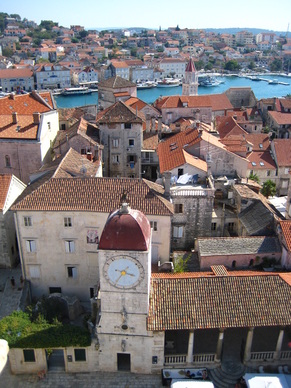 View of Trogir from bellfry Split was the site of the retirement palace of the Roman Emperor Diocletian at the turn of the 4th century. Diocletian http://en.wikipedia.org/wiki/Diocletian was a fascinating emperor, coming from a Croatian slave family before rising up to the rank of Emperor through military and political cunning. He bears the distinction of being the first emperor to think up the idea of retirement (I like this guy already!) and one of the few to die of natural causes. His retirement palace was a massive structure that would alter the course of Split’s history. About 300 years after his death, as the Roman empire fell, the citizens of Diocletian’s native Salona fled to the now ruined palace as a place of refuge. There they set up shops and homes in the halls and towers of the palace – slowly modifying it into what would become the center of the city of Split. To this day, the palace still occupies the center of the city, and Neda & I had a wonderful time exploring its ruins. We climbed the bell tower (built later next to Diocletian’s mausoleum) for sweeping views over the palace and city and also climbed a hill outside the city, where we would have enjoyed a beer as the sun set on Split if we’d have remembered to bring some cash! We also took a day trip to Trogir, a well preserved medieval town just north of Split. See all of our pics of Split and Trogir here: http://flic.kr/s/aHsjBDgBfQ. From Split we took a ferry to ancient town of Stari Grad on the island of Hvar. Stari Grad is the oldest recorded town in Croatia, though for us it was all about sipping white wine at cafés, enjoying the town’s splendid rock beaches, and catching a showing of the local film “Lavender Man”. Full of inside jokes about the island and horribly drab dialogue between the superhero Lavendar Man and an investigating reporter, I fell asleep on the film pretty rapidly, despite my attempts at revival with a Jack and Coke! Hvar Town on the other side of the island features some interesting architecture, as the Spanjola Fortress rises behind the city’s cathedrals and palaces. After a day stop here, we were off to Korcula, our next island. 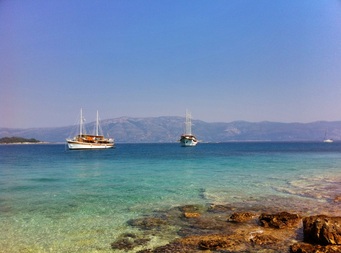 The beautiful Lumbarda Beach!! Korcula Town is a beautifully symmetric bit of land that juts out into sea in the shape of a leaf. The town is laid out like the veins of the leaf, with a main street running down the middle and side streets branching off from there. This keeps much of the old town in shade during the hot summer days. Korcula is also the first town on record to outlaw slavery in 1214. The town is very very small and so suffers a bit from tourist overload, but a short bus ride to Lumbarda brought beautiful beaches, delicious local white wines (yet again), and one of our favorite meals – the Lumbardian platter in a restaurant based in an abandoned boathouse on the beach. Island food in Croatia revolves several dishes, which we often enjoyed. There is the Octopus Salad, which when prepared with oil, citrus juices, red onions, and capers becomes a cacophony of flavors on the palate. We also savored the salted and marinated anchovies, the sheep cheese from the island of Pag, and the delicious prosciutto (though the prosciutto didn’t quite compare to our trip in Italy!). See all the pics of Hvar and Korcula here: http://flic.kr/s/aHsjBHbhCs. 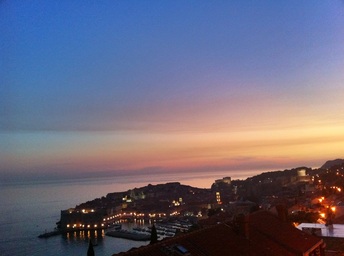 Mesmerizing view of Dubrovnik from our balcony Finally, our trip in Croatia ended all the way on the southern tip with the stunning city of Dubrovnik. Dubrovnik holds special significance for Croatians because during medieval times the city and its small republic (called Ragusa) managed to stay mostly independent in its governance. It was one of the most important port cities in all of Europe and its connections and trading posts in what is today Eastern Europe allowed it to turn fat profits as it resold goods to its Western neighbors. The result of this wealth, as well as an earthquake in 1667 that leveled most of the city, is an orderly Baroque city with towering city walls, smooth marbled streets, and a variety of lovely palaces, cathedrals, and fortresses. Neda and I got a lot of exercise while staying in Dubrovnik, staying in a hotel up the hill outside of the old city. Our location was rewarded with stunning views of the city and a 900 step walk down to the beach! While in Dubronik, we stayed healthy by eating at the wonderful salad bar at Nishta and stayed naughty with cigars and wine outside of Orlando’s fountain while listening to jazz. Dubrovnik is best avoided during the peak of the day, when visiting cruise ships turn it into a sardine can, but in the early morning and in the evenings the town settles back into lucidity and can be enjoyed in all of its stunning beauty. Our intended trip to the island of Mljet was also deep sixed when we arrived at the ferry an hour early, only to miss the last tickets by about 10 people. So, a day trip to the beautiful Tristeno gardens in lieu of Mljet soothed us with its beautiful Neptune fountain. Finally, we flew up to Zagreb, where we had a few hours to explore the city before heading off to Slovenia. See all of our pics of Dubrovnik, Tristeno, and Zagreb here: http://flic.kr/s/aHsjBQjkiq. All in all, Croatia was a beautiful country and a great place to meet up with our friends. But as it relied on tourism as its number one trade, authentic experiences were a bit more difficult to find along the coast, causing Neda and me to feel like we were really on typical recreational vacation more so than in most other places. This is a good thing in some ways, but not so good for our wallets, which were burning up as we passed through the tourism tunnel that is the Croatian coast. We were glad to leave the beach and the beauty behind and head for less crowded territory in the tiny country of Slovenia…
|